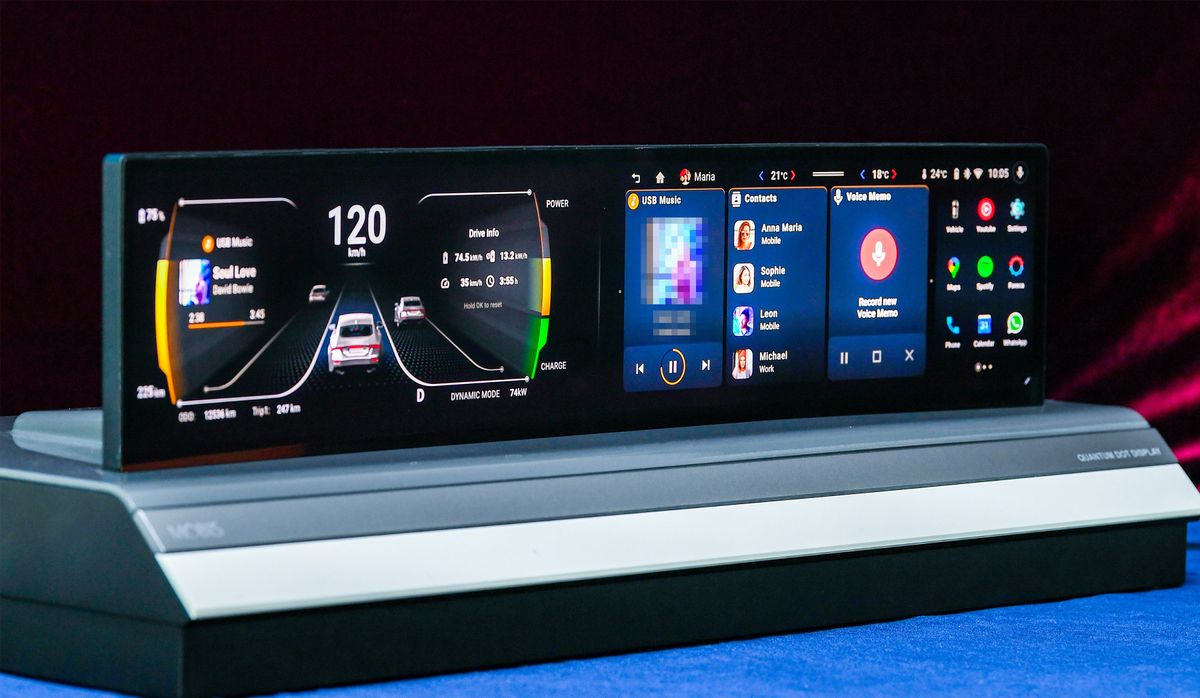Colorful, plus-sized display screens are proliferating in modern cars, turning them into rolling man caves: Driver instrument panels swiftly reconfigure to show maps or other data. Ferrari and Stellantis offer front shotgun passengers an interactive screen to futz with. BMW and other brands dangle lavish multimedia streaming systems for the back. Now Hyundai Mobis—the parts and components arm of the South Korean automaker—has upped the ante with a quantum dot screen that rivals the performance of even top-shelf OLED tech but at a substantially discounted price.
Tesla arguably kicked off the dashboard screen arms race—or perhaps fingertip battle—with the gee-whiz reveal of a 43-centimeter LCD touchscreen on its Model S sedan in 2009. Today, Lucid offers a 86-cm curved beauty on its electric Air sedan. And Mercedes-Benz took Jumbotron-style bragging rights with its “Hyperscreen,” a glass-sandwiched, 142-cm digital billboard that spans the entire dashboard on models including the flagship EQS electric sedan.
But as screens hog more interior real estate, their price can be a challenge for manufacturers, including for mainstream models that aspire to luxury-level features and tech. Which cues Hyundai Mobis’s recent unveiling of a low-cost dashboard display whose eye-popping colors and clarity rival the best OLED tech.
The South Korea-based supplier, and Hyundai Motor Group subsidiary, announced a world’s first with a “QL” display that combines two technologies: quantum dot and local dimming. Hyundai Mobis, the world’s sixth largest automotive supplier in terms of revenue, says they will privately show the display to potential automaker customers at CES 2024 in Las Vegas in January. (Be sure to follow Spectrum‘s CES 2024 coverage during the week of the show, starting Jan. 8.)
“As displays become larger in vehicles, the competitive pricing of QL displays will be an advantage for automakers and customers compared to OLED,” a Hyundai Mobis spokesperson said.
The company says its QL display improves the 70-percent color gamut of an LCD display to nearly 100 percent. Local dimming increases contrast between light and dark colors. Versus LCDs, quantum dots can reveal many more colors—potentially upwards of one billion—even at brightness levels that take advantage of newer techs like high dynamic range (HDR). And where even OLED colors may wash out in scenes that demand full brightness, quantum dot displays can faithfully reproduce those vivid tones in any light. In addition, where the organic material in an OLED will fade and lose “color expression” as it ages, a quantum LED should maintain that color expression throughout its lifetime.
The dots themselves are nanoparticles with semiconductive properties, added to a film that’s layered in a familiar LCD sandwich, all backlit by an LED. Under illumination, the quantum dots re-emit light of a specific bandwidth. The particles’ size determines the wavelength and color produced: Larger 10-nanometer dots emit light skewed toward red, and the smallest 2-nanometer dots skew toward green. The tech has gained a foothold in the premium TV market, but is now expanding into commercial applications such as digital signage. The displays can achieve peak brightness levels roughly as high as 4,000 nits, enough for outdoor signs to overcome the glare of direct sunlight.
For automobiles, the global market “is trending toward luxury with integrated large-screen structures extending from the driver’s seat to the passenger side,” the company said. “Technology such as the QL display, which enables high definition and slim design, is essential for mass production.”
Slimming the screen to match the best OLED’s was a key design challenge, according to a Hyundai Mobis company representative. The display coming to CES 2024 combines a 68.5-cm curved screen with a 14.5-mm thickness, with the ability to narrow that to 10 mm for customers who demand a thinner screen. Versus an OLED, the company says the QL screen can also reduce power consumption by nearly 50 percent.
The science of car screens has come a long way since 1986, when the Buick Riviera offered the first automotive touchscreen—a full decade ahead of any rival. The Buick sedan’s “Graphic Control Center” featured a postcard-sized, cathode–ray tube display with a telltale, sickly green glow. Today, even affordable cars from mainstream brands are offering generous touchscreens with handsome graphics or animations, Internet connections, over-the-air updates and a selection of apps. Apple Car Play and Android Auto are nearly ubiquitous for car owners who demand 24/7 connectivity.
Hyundai Mobis would not disclose which automakers it will pitch the QL display to, at CES or beyond. But Hyundai would seem a natural contender, not least with Hyundai Motor being Mobis’ corporate parent. The Hyundai and Kia brands, along with Hyundai’s fast-rising Genesis luxury brand, have won acclaim in recent years for their overachieving interiors, from striking design to technical proficiency and lavish features. If Hyundai Mobis can give those value-conscious brands an even-richer screen experience, at a lower manufacturing cost, a QL screen in those South Korean cars may not be far behind.
Lawrence Ulrich is an award-winning auto writer and former chief auto critic at The New York Times and The Detroit Free Press.



